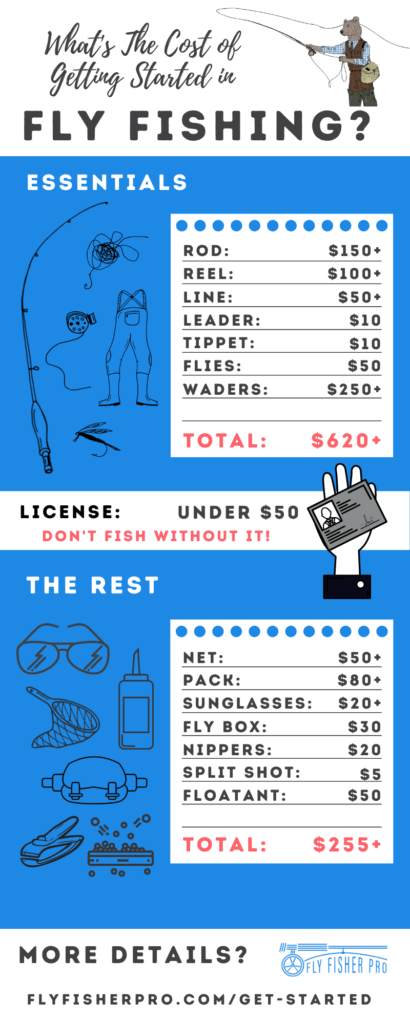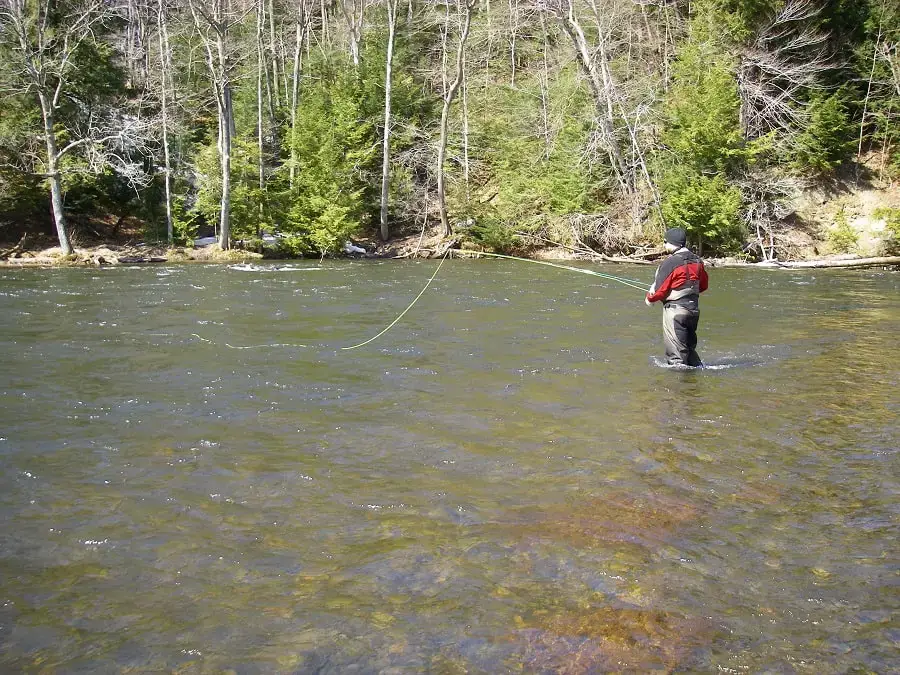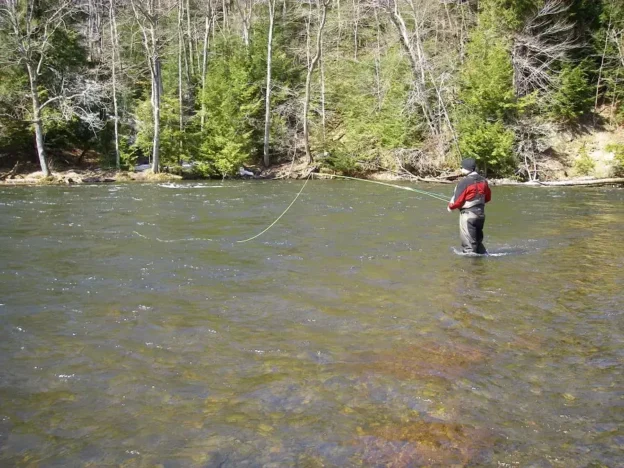Are you curious about the cost of getting into fly fishing? Well, you’ve come to the right place! Fly fishing, a sport loved by many outdoor enthusiasts, offers a unique and immersive experience. However, like any hobby or sport, it’s important to consider the financial aspects before diving in. In this article, we’ll explore the various costs associated with fly fishing, from equipment to licenses, and provide you with a clear understanding of what to expect when entering this captivating world of angling. So, grab your waders and let’s start calculating!
Equipment
Rods
When it comes to fly fishing, the rod is your most essential piece of equipment. There are various types and sizes of fly rods available, each designed for different fishing conditions and techniques. The cost of a fly rod can range widely depending on the brand, material, and quality. Entry-level rods can start as low as $50, while high-end rods can cost several hundred dollars. It’s important to find a rod that suits your casting style and fishing needs.
Reels
Fly reels are an important component of your fly fishing setup, as they hold and control the fly line. While the rod does most of the work in casting, the reel plays a crucial role in landing and fighting fish. Similar to rods, the cost of fly reels can vary greatly. Entry-level reels can be purchased for around $50, while high-quality reels can cost several hundred dollars. Consider the type of fishing you’ll be doing and the species you want to target when selecting a reel.
Lines
Fly lines are specifically designed to be cast using a fly rod and reel. They come in different weights and tapers to match various fishing situations and species. The cost of fly lines can range from $20 to $100 or more, depending on the brand and quality. It’s important to choose a line that matches the weight of your rod and the type of fishing you’ll be doing.
Leaders and Tippets
Leaders and tippets are the transparent sections of line that connect the fly line to the fly. Leaders are thicker and tapered, while tippets are thinner and more delicate. These components are essential for presenting the fly to the fish in a natural manner. Leaders and tippets can be purchased separately or in combination packs, with prices ranging from $5 to $20 or more.
Fly Assortment
A variety of flies is necessary for fly fishing success. Flies imitate different insects and baitfish, which are the primary food sources for fish. The cost of flies can vary depending on the brand, quality, and complexity of the patterns. Flies typically range from $1 to $5 each, and it’s recommended to have a diverse assortment to match different fishing conditions.
Waders
Waders are waterproof pants or overalls worn by fly anglers to keep dry while fishing in rivers, streams, or lakes. They allow you to access areas that would otherwise be inaccessible, increasing your fishing opportunities. The cost of waders can range from $100 to $500 or more, depending on the material, quality, and additional features such as built-in boots or stocking feet. It’s crucial to find waders that fit well and provide adequate comfort and mobility.
Boots
Fly fishing boots are designed to provide traction and support while wading in water. They come in various styles, including bootfoot and stockingfoot options. The cost of fly fishing boots can range from $50 to several hundred dollars, depending on the brand and quality. It’s important to find boots that fit well and provide sufficient ankle support for safety and stability.
Flies
Flies are an essential part of your fly fishing arsenal. They mimic the natural insects and baitfish that fish feed on, enticing them to strike. The cost of flies varies depending on the patterns and materials used. While some simple flies can be purchased for a dollar or two, more intricate and specialized patterns can cost up to $10 or more. It’s recommended to have a variety of flies in different sizes, colors, and patterns to increase your chances of success on the water.
Fishing Vest or Pack
A fishing vest or pack is used to carry all your necessary fly fishing gear and accessories. Vests are worn around the chest, while packs are worn like backpacks. The cost of a fishing vest or pack can range from $50 to $200 or more, depending on the brand, capacity, and features. It’s essential to choose a vest or pack that suits your storage needs and offers convenience and comfort while on the water.
Accessories
There are several accessories that can enhance your fly fishing experience. These include tools such as forceps, nippers, and line clippers for rigging and knot tying, floatant and sinkant for treating flies and lines, and fly boxes for organized fly storage. The cost of these accessories can vary widely, with individual items ranging from a few dollars to $50 or more. It’s important to invest in high-quality accessories that are durable and functional.
Lessons and Guides
Fly Casting Lesson
Taking a fly casting lesson is highly recommended for beginners. Proper casting techniques are crucial for accurate and efficient fly fishing. Fly casting lessons can be provided by certified instructors or experienced guides. The cost of a fly casting lesson can range from $50 to $200 or more per hour, depending on the instructor’s qualifications and location. Investing in a casting lesson will help you develop good casting habits and improve your overall fly fishing skills.
Fly Tying Lesson
Fly tying is the art of creating your own fly patterns using various materials and tools. Learning how to tie flies allows you to customize your patterns and save money compared to buying pre-made flies. Fly tying lessons can be taken at local fly shops or through online tutorials. The cost of fly tying lessons can range from $25 to $100 or more, depending on the duration and level of expertise provided. It’s an enjoyable hobby that adds another dimension to your fly fishing experience.
Guided Fishing Trip
For an unforgettable fly fishing experience, consider booking a guided fishing trip. Guided trips are led by experienced anglers who know the local waters and fishing techniques. They provide valuable insights, improve your skills, and increase your chances of success on the water. The cost of a guided fishing trip can vary depending on the location, duration, and services provided. Full-day guided trips can start around $300 and go up to $1,000 or more, depending on the destination and accommodations. While it may be a significant investment, the knowledge gained and memories made during a guided trip are priceless.

This image is property of troutandsteelhead.net.
Permits and Licenses
Fishing License
Before you hit the water, it’s crucial to have a valid fishing license. Fishing licenses are required by law, and the fees help support fishery conservation and management efforts. The cost of a fishing license can vary depending on the state or country and the duration of the license. In the United States, annual fishing licenses can range from $20 to $150 or more, depending on the state and residency status. It’s important to check the local regulations and obtain the necessary licenses before you start fishing.
Permits for Specific Waters
Some fishing locations require additional permits or fees. These permits may include access to private waters, special regulations, or specific fishing seasons. The cost of these permits can vary widely, depending on the location and restrictions. It’s important to research and understand the permit requirements for the waters you plan to fish and budget accordingly.
Transportation
Fly Fishing Destination
Choosing a fly fishing destination involves considering factors such as the type of fish you want to target, the scenery you desire, and the overall fishing experience you seek. Destinations can range from local rivers and lakes to remote wilderness areas or exotic saltwater flats. The cost of traveling to a fly fishing destination will depend on the distance, transportation method, and accommodations. Local trips may require minimal travel expenses, while international or remote trips can involve significant airfare, lodging, and transportation costs.
Travel Costs
When planning a fly fishing trip, it’s essential to budget for travel expenses. These costs can include airfare or gas for transportation, lodging accommodations, meals, and any additional activities or excursions. The prices for these expenses will vary significantly depending on the destination and the level of comfort you seek. Researching and planning ahead can help you find the best deals and make the most of your fly fishing adventure.

This image is property of flyfisherpro.com.
Maintenance and Repairs
Rod and Reel Maintenance
Proper maintenance is essential to ensure the longevity and performance of your fly fishing gear. Rod and reel maintenance typically involves cleaning, lubricating, and inspecting these components regularly. Cleaning can be done using a mild soap and water solution, and lubrication can be applied using specific reel and rod oils. It’s important to follow the manufacturer’s instructions and recommendations for maintaining your specific gear.
Fly Line Care
Fly lines are subjected to wear and tear due to exposure to the elements and repeated casting. Regular cleaning and conditioning are necessary to maintain their performance. Fly line cleaners and conditioners are available and should be used according to the manufacturer’s instructions. It’s recommended to clean and condition your fly line after every few fishing trips or whenever they start showing signs of wear.
Wader and Boot Care
Waders and boots can be subjected to harsh conditions, including mud, rocks, and water exposure. Proper care and maintenance can extend their lifespan. After each use, rinse off any dirt or debris from the waders and boots and hang them to dry. Periodically, they should be cleaned with a mild detergent and treated with a waterproofing spray if necessary. Inspect the waders for any signs of damage and repair them promptly to prevent further issues.
Fly Repair and Replacement
Flies are prone to damage, especially when fish are caught or when casting into the vegetation. It’s important to inspect your flies regularly for any signs of wear or damage and replace them as needed. Consider carrying a fly repair kit with replacement hooks, threads, and materials to make quick repairs on the water. By maintaining a well-stocked supply of flies and keeping them in good condition, you’ll increase your chances of success on each fishing outing.
Storage and Organization
Rod and Reel Storage
Proper storage of your fly fishing gear is important to protect it from damage and prolong its lifespan. Rods should be stored safely in rod tubes or racks, ensuring they are protected from impact or bending. Reels can be stored attached to the rods or separately, depending on your preference. It’s recommended to store reels in protective reel cases or pouches to prevent scratches or damage.
Fly Box and Organization Systems
Fly boxes are used to store and organize your fly assortment. They come in various sizes, designs, and materials. It’s important to choose a fly box that suits your needs, whether it be a small pocket-sized box for minimal flies or a larger compartmentalized box for a diverse assortment. Additionally, there are various organization systems available, such as magnetic sheets or foam inserts, to keep your flies securely in place.

This image is property of curated-uploads.imgix.net.
Apparel
Wicking and Quick-drying Clothing
When fly fishing, it’s essential to wear clothing that wicks away moisture and dries quickly. This helps to regulate body temperature and keep you comfortable throughout the day. Fabrics such as synthetic blends or merino wool are popular choices for base layers and shirts. It’s recommended to avoid cotton as it retains moisture and can lead to discomfort.
Layering System
Layering is crucial for adapting to changing weather conditions while fly fishing. Using a layering system allows you to add or remove clothing as needed to stay comfortable. A typical layering system includes a base layer, insulation layer, and outer shell. This system provides versatility and ensures you’re prepared for a range of weather conditions.
Sun Protection
Proper sun protection is essential during fly fishing to prevent sunburn and reduce the risk of long-term skin damage. Wearing a wide-brimmed hat, polarized sunglasses, and sunscreen with a high SPF is recommended. Consider clothing with UPF (Ultraviolet Protection Factor) ratings for additional sun protection.
Rain Gear
Rain gear is a must-have when fishing in wet or rainy conditions. A waterproof and breathable rain jacket and pants will keep you dry and comfortable. Look for materials with high waterproof ratings and taped seams to ensure complete protection from the elements.
Footwear
Choosing the right footwear for fly fishing is crucial for safety and comfort. Wading boots with felt or rubber soles provide traction on slippery rocks and riverbeds. Stockingfoot waders require separate wading boots, while bootfoot waders have the boots attached. It’s important to select boots with good ankle support and a proper fit to prevent injuries and ensure a comfortable fishing experience.
Books and Resources
Fly Fishing Books
There is a wealth of valuable information available in fly fishing books. Reading books written by experienced anglers and experts can expand your knowledge and improve your skills. From fly tying techniques to fish behavior and river tactics, there is a wide range of topics covered in fly fishing literature. Prices for fly fishing books can vary from $10 to $50 or more, depending on the author, content, and edition.
Online Forums and Websites
Online forums and websites dedicated to fly fishing are excellent resources for obtaining information, tips, and advice. These platforms provide opportunities to connect with fellow anglers, ask questions, and share experiences. Many websites also offer tutorials, gear reviews, and destination guides. Online forums and websites are typically free to access and a valuable source of knowledge for both beginners and experienced fly anglers.
Magazine Subscriptions
Subscribing to fly fishing magazines is a great way to stay up-to-date with the latest trends, techniques, and gear in the fly fishing world. Magazines often feature articles by renowned anglers, destination spotlights, and product reviews. Subscription prices vary depending on the magazine and duration, but typically range from $20 to $40 per year.

This image is property of curated-uploads.imgix.net.
Travel Gear
Fly Rod Travel Case
A fly rod travel case is essential for protecting your rod during transportation. It provides a secure compartment for your rod and reel, preventing damage during transit. Fly rod travel cases can range from simple fabric tubes to hard-shell cases. Prices vary depending on the design and quality.
Fly Reel Case
Similar to a rod case, a fly reel case offers protection for your reel during transportation. Reel cases can be purchased individually or as part of a rod and reel combo case. They come in a variety of designs and materials, providing a secure and organized storage solution for your reels.
Fly Boxes and Storage
Fly boxes are necessary for storing and organizing your fly assortment. Additional fly storage systems, such as magnetic sheets or foam inserts, can be used to keep flies securely in place. Depending on your fly collection and organization needs, prices for fly boxes and storage solutions can vary.
Basic Tools and Accessories
Carrying essential tools and accessories can significantly enhance your fly fishing experience. These may include forceps, nippers, line clippers, knot tying tools, and hook sharpeners. Basic tool and accessory sets are available, combining multiple tools into one convenient package. Prices vary depending on the brand and number of items included.
Workshops and Events
Fly Fishing Workshops
Fly fishing workshops provide opportunities to learn from experienced instructors and improve your skills. These workshops cover various topics, from casting techniques to fly tying and river tactics. Prices for fly fishing workshops can vary depending on the duration, location, and expertise of the instructors.
Fly Fishing Expos and Events
Attending fly fishing expos and events is an excellent way to connect with the fly fishing community and gain insights from industry professionals. These events typically showcase the latest gear, offer product demonstrations, and provide educational seminars. Admission prices may vary depending on the event and any additional activities or workshops offered.
By considering all the aspects mentioned above, you can estimate the total cost of getting into fly fishing. While the initial investment may seem significant, fly fishing offers a rewarding and fulfilling experience that can last a lifetime. With proper planning, budgeting, and a love for the sport, you can embark on a fly fishing journey that will provide countless memories and a deep connection with nature.

This image is property of troutandsteelhead.net.
